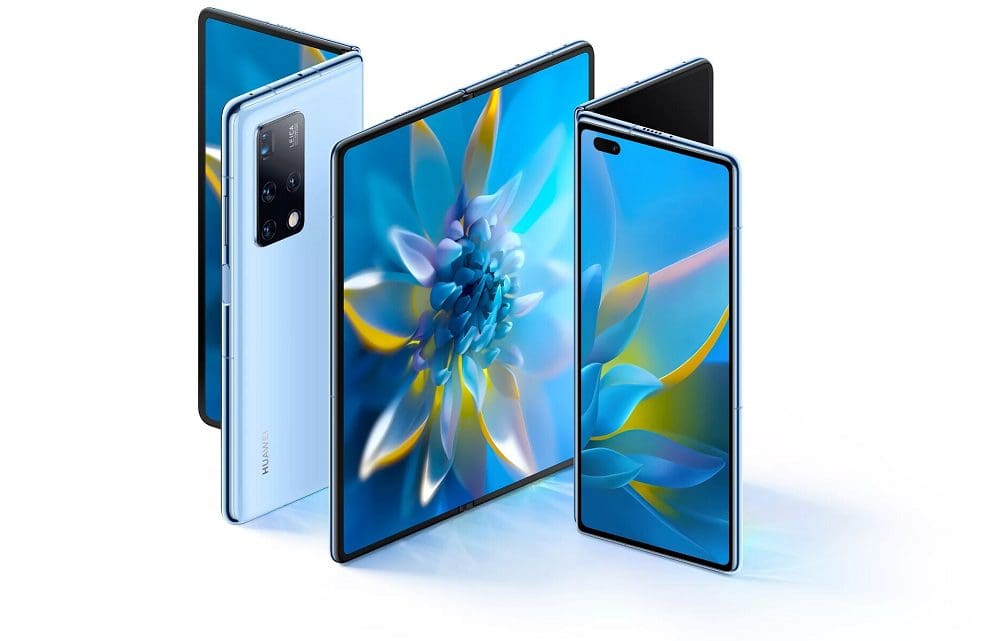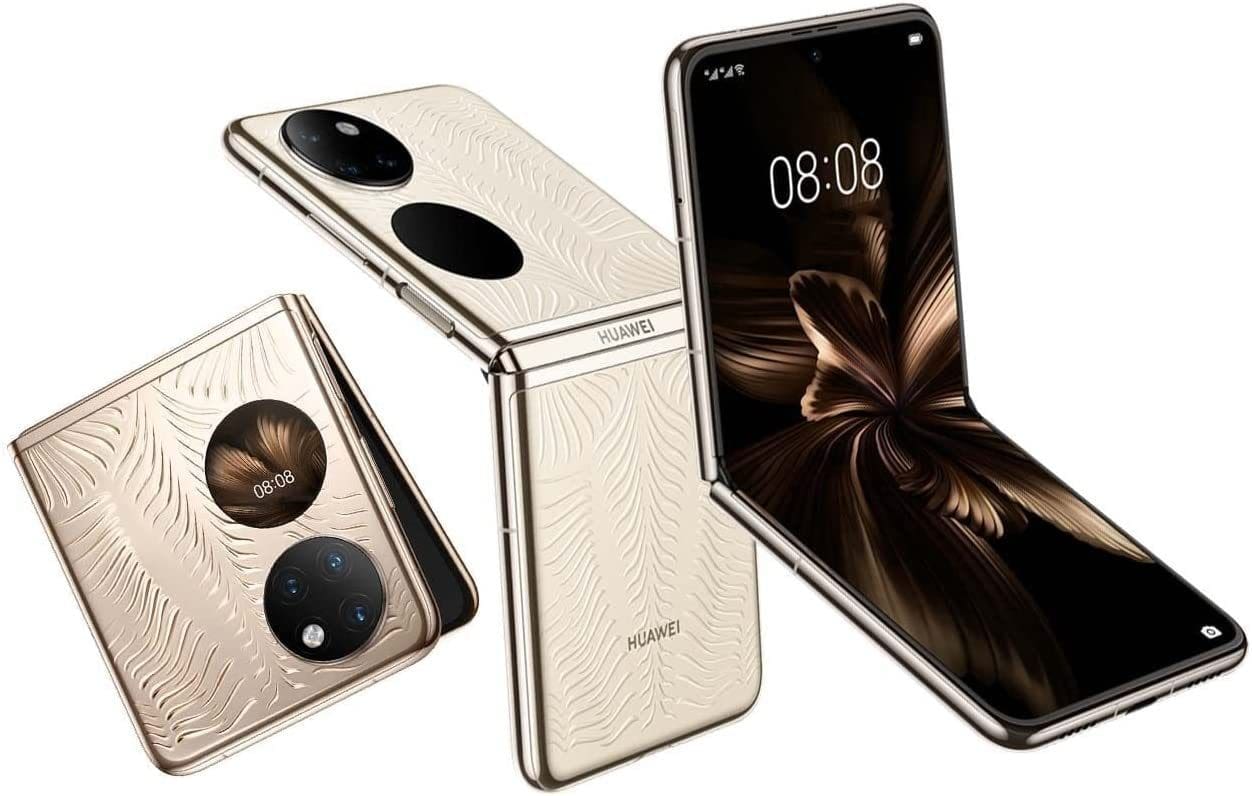The Huawei Mate X2 is the second entry in one of Huawei’s now three lines of foldable phones. The Mate X2 was released in February 2021. It made significant design changes from the original Mate X. Unfortunately, the release is exclusive to China, with no international release, and is only available in very limited numbers.
Contents
The Base Specs
The Huawei Mate X measures 161.8 x 145.8 x 8.2 mm when unfolded and 161.8 x 74.6 x 14.7 mm when folded. It is powered by the Kirin 9000 CPU and a 4500mAh battery.
The two halves of the phone are actually not symmetrical in terms of thickness, with both sides being slightly wedge-shaped. This design technically allows there to be no gap between the two halves when folded. But makes the phone lopsided in terms of weight balance and means it doesn’t sit well on flat surfaces. While it’s an exciting solution to the gap that Samsung still leaves between the two closed halves a generation later, Oppo and Honor have since pioneered more elegant solutions.
Models/Versions
At the time of its release, Huawei had two lines of foldable phones, though a third line has since been released. The Mate X series has a large central screen. The second-generation version we’re covering here has a foldable screen on the inside of the fold similar to other manufacturers. The Mate Xs series has a slightly smaller screen size and has the foldable screen located on the outside of the fold. The Pocket series also has a clamshell-style vertical fold and a much smaller form factor, similar to the Samsung Galaxy Flip series.
The Huawei Mate X2 is available in three capacities: a 256GB variant with 8GB of RAM, a 512GB variant with 8GB of RAM, and a 512GB variant with 12GB of RAM. All capacities support expandable storage with Huawei’s proprietary NanoMemory expansion cards up to 256GB in capacity, though this uses the second shared SIM slot.
Battery
The Huawei Mate X2 has a reasonably sized battery with a capacity of 450mAh. It can fast-charge at 55W with the included proprietary SuperCharge charger, though that can output a maximum of 66W. While it does support standard USB PowerDelivery charging, it only does so at significantly slower, non-fast-charge speeds. There is no support for wireless or reverse charging.
Many foldable phones have high-end hardware but only average battery capacities. This results in lower battery lives than you might see in flagship phones which already struggle to survive a full day of reasonably heavy use. With the slightly lower power draw, and performance of the Kirin CPU compared to the latest Snapdragon CPUs, the battery life is a bit better than you might expect. The large screen, however, has a big impact on battery life. If you need to make the most of a single charge, it’s best to limit use to just the cover screen.
Screen
The Huawei Mate X2 has a 8.0-inch foldable main screen with a resolution of 2200 x 2480 for a pixel density of 413 PPI. It has a 90Hz refresh rate, and a peak brightness of 542 nits. The secondary cover display is 6.45-inches across and has a resolution of 1160 x 2700 for a pixel density of 452 PPI. Again, its refresh rate is limited to just 90Hz. Neither screen officially support HDR10+ and support is spotty, in practice, however, some sources may be able to play HDR content, so your mileage may vary.
Cameras
The Huawei Mate X2 has a quad rear camera setup. A primary wide-angle camera has a 50MP 1/1.28-inch sensor with an f/1.9 lens. The telephoto camera has a 12MP sensor, an f/2.4 lens, and 3x optical zoom. There’s also a periscope telephoto camera with an 8MP sensor, an f/4.4 lens, and a 10x optical zoom. The final camera is an ultrawide with a 16MP sensor and an f/2.2 lens. The cover screen has a hole-punch selfie camera with a 16MP sensor and an f/2.2 lens.
The rear cameras are a strong point of the Mate X2. The pair of telephoto cameras work well together to provide excellent optical zoom capabilities. The 10x optical zoom can even be combined with digital zoom for up to 100x zoom. Obviously, this comes with some reduction in quality, but not as much as you’d see on other phones lacking a 10x optical zoom.
The ultrawide also features autofocus and so can pull double duty as a macro camera. Low light performance isn’t great, but is acceptable, with long exposure and processing times in night mode to get decent pictures. The selfie camera is perfectly normal and acceptable, but likely rarely used. It does have an unusually large, elongated hole punch. The main screen does not have any form of selfie camera. Video-wise, the rear cameras can record in 4K or 1080p both 30 and 60fps. The selfie camera can only record at 1080p30.
Software/OS
The Huawei Mate X2 was released with Android 10 and the EMUI 11 skin. An update to HarmonyOS is available. Being a China regional exclusive and more importantly a Huawei device. The Mate X2 also doesn’t support Google Play services which may be a big issue for potential western buyers looking to import one.
Features
The single most prominent feature of the Huawei Mate X2 is, of course, the ability to flip the phone open and closed. The hinge design is decent allowing the screens to be flush against each other, though this comes at the cost of the uneven wedge-shaped halves. The crease is present and noticeable, but less so than on Samsung’s foldable devices.
The joint of the phone, unlike most foldable phones, is easy to move, only holding position reliably in the fully open or fully closed positions. It can’t easily be partially folded and just left to rest there as the hinge isn’t stiff.
There is a fingerprint reader, however, unlike most modern high-end phones, it isn’t embedded under the screen. Instead, it’s a classic side power button/fingerprint reader combo. This makes some sense as the single sensor can be used to unlock the phone when it’s closed, open, or somewhere in between. The phone can also be unlocked with facial recognition.
Dual SIM cards are supported, though the second slot also doubles as the NanoMemory expandable storage slot. Wi-Fi 6 is supported for high-speed home networking, and 5G is supported for the fastest mobile data speeds.
Price
The 256GB model has a retail price of ¥ 17999, which is roughly $2650. The 512GB model with 12GB of RAM, sells for ¥18999, approximately $2798. The phone has an extremely short supply, mainly a tech demo with a sky-high price. Being a China-exclusive and with limited numbers, you’ll struggle to find it outside the region. However, some international resellers may occasionally have models.
Be careful where you buy from, with the limited numbers and high price, it may well be a popular target for unscrupulous sellers and web stores. We highly recommend you use a payment service that will reliably respond to refund requests or chargebacks to help you get your money back in the case of fraud.
Improvements Over Previous Generations
The previous generation of the Mate X has the foldable screen bend around the outside of the fold. The change to an interior folding screen with a secondary cover screen brings them more in line with the rest of the industry and helps to protect the screen. The CPU, obviously, has been upgraded from the previous generation. The screens now run at 90Hz, rather than 60. The cameras are better in all regards, though a ToF sensor is missing. The Mate X2 also has stereo audio.
Summary
The Huawei Mate X2 is a solid foldable phone. Unlike many foldable phones, it features an excellent camera set. Performance is generally reasonable across the board, though it’s not quite top tier. The lack of any waterproofing rating and the limit of just 90Hz on the displays may put some potential users off.
Concerns about the lifespan of the fold in the screen are likely to be difficult to assuage. The price, however, is likely to be the main issue. At over $2500, the Mate X2 is extremely expensive, assuming you can even find one in stock. Flagship phones with significantly better performance and features are available for more than $1000 less. The real question is do you really want, or need, a phone that folds? If that’s the case, you’ll have to accept some compromises, and, in this case, a sky-high price tag.
What are your thoughts on the phone? Share your thoughts in the comments below.




